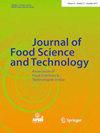用四氮唑盐和电子介质评价酵母在不透明分散体系中的生长的比色试验
IF 3.3
3区 农林科学
Q2 FOOD SCIENCE & TECHNOLOGY
引用次数: 2
摘要
背景:传统的微生物计数技术如菌落计数是费时的。浊度增长目视评价缺乏客观性和准确性。另一方面,分光光度法读数的准确性可能受到介质不透明度和/或添加剂的限制。在这种情况下,基于四氮唑盐的比色法是传统方法的替代方法,因为它们能够根据颜色变化产生端点。本研究的目的是开发一种基于两种不同的四氮唑盐和电子介质的比色测定方法,以取代传统的活菌板计数或吸光度方法,用于不透明分散系统中的微生物生长检测。方法:采用2,3,5-三苯基- 2h -四氯化氮(TTC)、2-(4-碘苯基)-3-(4-硝基苯基)-5 -苯基- 2h -四氯化氮(INT)和电子介质2-甲氧基-1,4-萘醌(MNQ)两种四唑盐,建立了在肉汤和不透明分散体系中评价酵母生长的显色法。此外,用该方法测定了纳他霉素和柠檬草精油对白耳酵母的最低抑菌浓度,并与传统的肉汤微量稀释法和平板计数法进行了比较。结果:与TTC/MNQ相比,INT/MNQ的联合用药效果更好。在不透明结构体系中,后者比吸光度更敏感,而在肉汤中,检测酵母生长的灵敏度与吸光度相当。此外,INT/MNQ试剂可以充分确定不透明结构体系中抗菌剂的最低抑制浓度。结论:这些结果表明,所提出的方法能够充分地确定不透明结构体系中抗菌剂的最低抑制浓度,与平板计数法非常一致,并且所提出的技术允许在较低的种群水平下评估酵母生长,而不是通过吸光度读数所需的水平。此外,该比色法操作简单,耗时短。本文章由计算机程序翻译,如有差异,请以英文原文为准。
A colorimetric assay using tetrazolium salts with an electron mediator to evaluate yeast growth in opaque dispersed systems
Background: Traditional microbiological enumeration techniques such as colony count are time consuming. Visual evaluation of turbidity growth lacks objectivity and precision. On the other hand, the accuracy of the spectrophotometric readings can be limited by media opacity and/or additives. In this context, colorimetric methods based on tetrazolium salts are an alternative to traditional methods due to their ability to generate endpoints based on color change. The objective of this study was to develop a colorimetric assay based on two different tetrazolium salts and an electron mediator in order to replace the conventional method of viable plate count or absorbance for microbial growth detection in opaque dispersed systems. Methods: A color imetr ic method to evaluate yeast growth in broth and opaque dispersed systems using two tetrazolium salts, 2,3,5-triphenyl-2H-tetrazolium chloride (TTC), 2-(4-Iodophenyl)-3-(4-nitrophenyl)-5 -phenyl-2H-tetrazolium chloride (INT) and an electron mediator, 2-methoxy-1,4-Naphthoquinone (MNQ) was developed. In addition, the minimum inhibitory concentrations against Zygosaccharomyces bailii for natamycin and lemongrass essential oil were determined by the proposed method and compared with those obtained using the conventional broth microdilution and plate count methods. Results: Showed that the mixture of INT/MNQ, was more effective than TTC/MNQ. In opaque structure systems, the later showed to be more sensitive than absorbance However, in broth it was as sensitivity as absorbance to detect yeast growth. Besides, the INT/MNQ reagent functioned adequately to determine the minimum inhibitory concentrations of antimicrobials in opaque structured systems. Conclusions: These results demonstrated that the proposed method functioned adequately to determine the minimum inhibitory concentrations of antimicrobials in opaque structured systems showing an excellent agreement with the plate count method and the proposed technique allowed the evaluation of yeast growth with lower population levels than the ones required through absorbance readings. Moreover, this colorimetric method is easy to perform and less time consuming.
求助全文
通过发布文献求助,成功后即可免费获取论文全文。
去求助
来源期刊
CiteScore
7.70
自引率
0.00%
发文量
274
审稿时长
11 months
期刊介绍:
The Journal of Food Science and Technology (JFST) is the official publication of the Association of Food Scientists and Technologists of India (AFSTI). This monthly publishes peer-reviewed research papers and reviews in all branches of science, technology, packaging and engineering of foods and food products. Special emphasis is given to fundamental and applied research findings that have potential for enhancing product quality, extend shelf life of fresh and processed food products and improve process efficiency. Critical reviews on new perspectives in food handling and processing, innovative and emerging technologies and trends and future research in food products and food industry byproducts are also welcome. The journal also publishes book reviews relevant to all aspects of food science, technology and engineering.

 求助内容:
求助内容: 应助结果提醒方式:
应助结果提醒方式:


